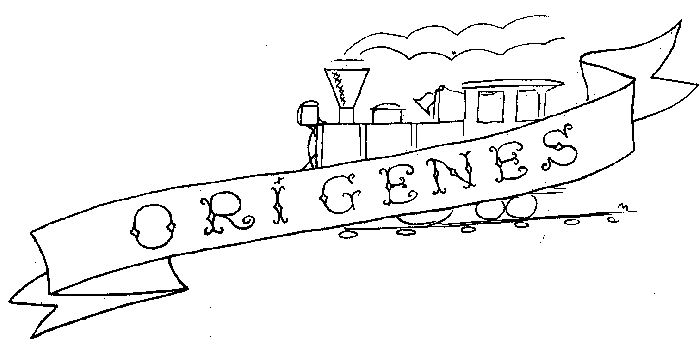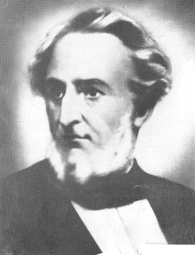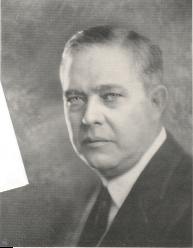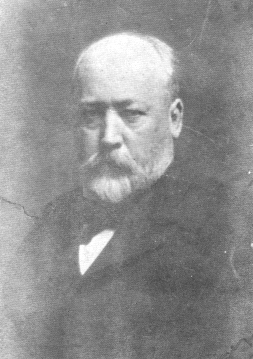| <<Previous Home | To see images full-size, click on the image | Next>> |

LA PERENNE inquietud de Gaspar Betancourt Cisneros por dar a su querido Puerto Príncipe impulsos que le incorporaran a las modernas corrientes de civilización, una de cuyas expresiones mejores era el "camino de hierro",
 |
| Gaspar Betancourt Cisneros (1803–1866) |
Al advenir la República, el servicio y significación de aquel tramo que daba entrada y salida a personas y mercancías, de Camagüey al mar y viceversa, despertaba el anhelo de acercamiento y la necesidad de lograr amplio horizonte y perspectiva de consolidación a la libertad conquistada con tanto sacrificio. Esa ansiedad potencial tuvo su intérprete y cumplida satisfacción en la iniciativa fecunda y labor oportuna del caballero canadiense Sir William Van Horne, gracias al cual corría el 8 de Diciembre de 1902 el primer tren, para unir el extremo oriental cubano con la provincia de las Villas, a donde llegaba el ferrocarril, hasta aquella fecha. Rápidamente se habían multiplicado aquellos 50 kilómetros de vía existentes en la Isla, como aislada huella de los días de El Lugareño. A los 288 kilómetros que unían a Santa Clara con La Habana, se conectaron en aquel día memorable 573 kilómetros más, por los que han fluido de uno a otro confín de la isla la prosperidad, la cultura, la fraternidad y la esperanza cubanas.
Ya desde aquellos días iniciales Camagüey se perfilaba como lo que es hoy, el centro ferroviario de Cuba. Van Horne apreció la situación geográfica y las múltiples conveniencias de la cuna de Agramonte, y aquí estableció su cuartel general y el vértice de las operaciones de la industria, con las oficinas generales y los extensos talleres de Garrido.
Siete años pasaron en la organización de "The Cuba Railroad Company" para lograr relativa normalidad en su desenvolvimiento y reemprender las ampliaciones menester. Ya en 1907 se bifurcaba la línea en Cacocum con 17 kilómetros por los que llegaban los trenes hasta Holguín; dos años después se acometía la construcción de la línea Martí-Bayamo-San Luis y el Ramal de Manzanillo, que se terminó en 1911, con 280 kilómetros de extensión total. Por aquella misma época, en la espléndida Bahía de Nipe aparecía el muelle de Antilla, al conjuro de dinámicos estimulantes.
Crecimiento y Perspectivas
EL FERROCARRIL iba extendiéndose y haciendo llegar sus benéficas influencias a todos los rincones, y en 1915 se preparaba la construcción de 99 kilómetros de vía férrea que acercan a Santa Cruz del Sur con la Capital de la Provincia camagüeyana, lo que se logró en 1923. En 1918 los trenes corrían por el más lindo Ramal de Cuba, bordeando las montañas trinitarias, para llevar sus viajeros a la colonial ciudad de palacios y leyendas.
Finalizaba casi el primer cuarto del siglo presente, —1916— cuando arriba a la industria ferroviaria una de sus más salientes figuras, que con antecedentes patrióticos, capacidad singular y personalidad relevante,
 |
| Coronel José M. Tarafa |
Trascendental acontecimiento para este sector del transporte fué la discutida legislación que consolidó la transportación ferroviaria en Las Villas, Camagüey y Oriente, propiciando que "The Cuba Railroad Company", "Ferrocarril de Camagüey a Nuevitas" y "Ferrocarriles del Norte de Cuba" integrarán en 1924 la empresa que desde entonces conocemos como Ferrocarriles Consolidados de Cuba, y que señala, con el decursar del tiempo, el acierto de la medida, por razones obvias.
Posteriores adquisiciones de los Ferrocarriles Consolidados de Cuba fueron el llamado Ferrocarril Espirituano con 42 kilómetros de extensión que une a Tunas de Zaza con Sancti Spíritus, realizada en 1927, y el Ferrocarril Guantánamo y Occidente de unos 125 kilómetros, y que unen a San Luis con Guantánamo, lo que se realizó en 1948.
Los estrechos nexos establecidos con la raíz de la economía general del país, a la que infiltra energías poderosas, y cuyas posibilidades tienen reflejos potentes en el ferrocarril, hacen que ambos experimenten las mismas oscilaciones, ritmándose la vida ferroviaria con la característica general de la nación, a tal extremo que aquella siempre resulta manifestación fiel de prosperidad o penuria de Cuba.
Demostración del aserto precedente es la intensa crisis económica del país en los años trigésimos de este siglo: restricciones de la producción azucarera, merma en el comercio doméstico y exterior, reajuste agrícola e industrial en toda la nación. Esto afectó medularmente a los Ferrocarriles Consolidados, que vieron descender los índices de su tráfico e ingresos hasta la mínima expresión, lo que impedía cubrir las nóminas y obligó al desplazamiento de más de cinco mil trabajadores; sin poder pensar siquiera en la reposición del material y mejoramiento de la vía ni tampoco en el adecuado mantenimiento del existente. Cuba y el Ferrocarril, coetáneos y unidos con el mismo signo del destino, vivieron y soportaron estoicamente las dificultades de aquella década.
THE CUBAN patriot Gaspar Betancourt Cisneros (1803–1866)—the illustrious Camagueyan who devoted life, wealth, and talent to the ideal of the deliverance of his homeland—repeatedly strove to give his beloved Puerto Principe [the original name for Camaguey] civilization’s latest modern conveniences, one of the most novel at that time being the “iron road.” After a series of magnificent efforts, and overcoming [Spain’s Governor-General of Cuba] Miguel Tacon’s (1775–1855) prejudice, his plans crystalized in 1836, when work began on the [50-mile] Puerto Principe & Nuevitas Railroad. A quick, comfortable trip by railroad replaced the slow trip by horse-and-wagon—taking three long days—required to reach the schooners that continued the trip three more days by sea to Havana. This improvement constituted significant progress and impelling motive for the inhabitants and commerce of the island’s central-eastern area, since Oriente province’s Sabanilla-Maroto Railroad did not open up as large an area to the sea.
[El Lugareño (The Villager) is the nickname by which Betancourt is known to all Cubans. The Puerto Principe & Nuevitas Railroad was the first railroad in service in all of Spain and its dominions. It was in service before any in Spain itself. Many Havana-centric Cubans believe that the Havana to Bejucal line was the first, but it first ran a year later, in 1837. —Ed.]
With the coming of the Republic the utility provided by that stretch of rail that connected Camaguey to the sea and vice-versa—and gave entrance and exit to persons and merchandise—awoke the yearning to be closer to our other countrymen. It was necessary to reach farther to consolidate the liberty gained with so much sacrifice. This important problem-to-be-solved had as its timely founder and implementer the Canadian gentleman Sir William Van Horne (1843-1915).

|
| Sir William Van Horne (1843-1915) |
From those first days Camaguey’s profile was the same as today’s: the rail center of Cuba. Van Horne appreciated the geographical location and various conveniences of Agramonte’s birthplace. [Ignacio Agramonte (1841-1873), another Cuban patriot, hailed from Camaguey. Camaguey is considered the cradle of the Cuban Revolution. —Ed.] Here he established the headquarters and operational vertex of the industry, with the general offices and the extensive Garrido shops.
Seven years later the organization of The Cuba Railroad Company reached its original goals and continued its development by undertaking additional needed expansion. By 1907 the line branched in Cacocum with 17 additional kilometers across which trains reached Holguin. Two years later construction of the Marti–Bayamo–San Luis as well as the Manzanillo branches began. This was finished in 1911, adding a total of 280 kilometers (174 miles). During that same time, docks at Antilla on that splendid Nipe Bay appeared, conjured up by all this dynamic stimulant.
Growth and Outlook
THE RAILROAD continued to spread out, causing its benefits and influences to arrive at every corner of the land. In 1915 construction preparations began for the 99 kilometer (61½ mile) steel rails that would put Santa Cruz del Sur closer to the capital of its province, Camaguey. It was completed in 1925. In 1918 the trains ran through the most beautiful branch line in Cuba, skirting the Trinitarian Mountains, to bring its passengers to the colonial city of palaces and legends [Camaguey].
Towards the end of the first quarter of the present century—1916—one of the railroad industry’s most prominent, patriotic, exceptional, and outstanding figures integrates the group of precursors. His name: Colonel Jose M. Tarafa. His accomplishments include: the founding of The Northern Railroad of Cuba, whose trains first ran in April 1918; the quick flowering of that area, increasing agricultural concerns in Chamblas, Florencia and Moron; the establishment of the sugar mills of Violeta, Velasco and others; the creation of the largest center of sugar exportation in the world at Nuevitas Bay [now called Puerto Tarafa], at a cost of five million [US] dollars. All this due to the to the talent, hard work, robust spirit, and able entrepreneurship of the distinguished Colonel Tarafa.
In 1924, controversial legislation combined railway transportation in Las Villas, Camaguey and Oriente provinces into Consolidated Railroads of Cuba; these being The Cuba Railroad Company, Camaguey & Nuevitas Railroad and The Northern Railroad of Cuba. Now that time has passed, it is obvious that this plan was successful.
Subsequent acquisitions of Consolidated Railroads of Cuba includes the so-called Espirituano Railroad in 1927, with 42 kilometers of track connecting Tunas de Zaza with Sancti Spiritus in 1927; and the Guantanamo and Western Railroad in 1948, with 125 kilometers connecting San Luis with Guantanamo.
The tight link between the general economy of the country and that of the railroad—both of which exert powerful influences on one another—means that the economic rhythm of the railroad, whether prosperity or poverty, faithfully matches, beat for beat, the economic rhythm of Cuba.
Proof of this assertion occurred in the thirties earlier this century when a severe economic crisis triggered reduced sugar production, shrinkage in domestic and international commerce, and agricultural and industrial readjustments throughout the nation. This directly affected Consolidated Railroads, who saw its traffic and revenue indices drop to its lowest levels, impeding its ability to cover its bonds and caused the displacement of more than five thousand workers. During that time the railroad could not adequately maintain or even think about refurbishing its property. Cuba and the Railroad, united day-to-day by the same destiny, survived and stoically assisted each other during that decade’s difficulties.

| Camaguey Population | ||
| 1878 | — | 46,000 |
| 1899 | — | 25,000 |
| 1907 | — | 30,000 |
| 1928 | — | 93,000 |
| 1943 | — | 155,000 |
| 1950 | — | 204,000 |
| <<Previous Home | To see images full-size, click on the image | Next>> |
